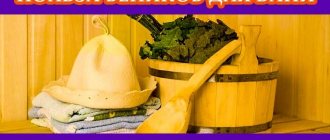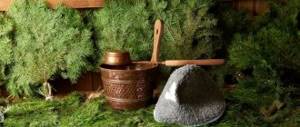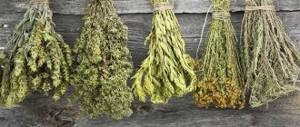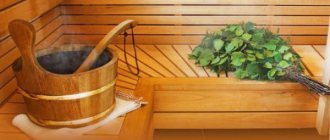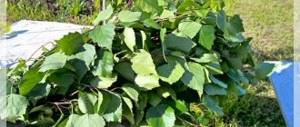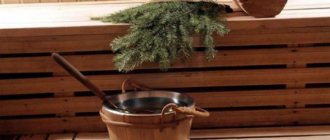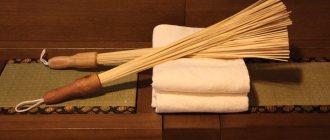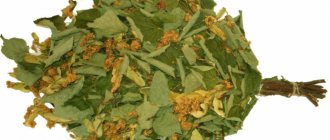How to knit brooms for a bath
Greetings to all lovers of a real Russian bath!
True connoisseurs of hot steam simply cannot imagine a bathhouse without a broom. For them he is a source of cheerfulness, good mood, and in some cases an excellent healer. This is all true.
But, in order for the steam season not to stop, but to last all year round, you need to take care in advance of preparing the most necessary bath accessory. As they say, prepare your sleigh in the summer. We'll talk about how to cook and how to knit brooms for a bath below. It would seem, what is smart here? But, as Dunno said: every task requires learning...
When to cut birch and oak branches
If we are talking about how to knit brooms for a birch bath, then there is a clear period of time from the 11th to the 30th, when there are no earrings on the trees yet.
But it is necessary to take into account the general condition of the foliage:
- For a birch broom to be good for a bath, the outer part of the leaf should not be rough, but on the contrary, it should feel soft and velvety to the touch;
- when you try to pull the sheet, only a small part of it should come off, and not the entire plate.
If we talk about the timing of harvesting oak brooms for a bathhouse, then they fall in the second half of July or the beginning of August. By that time, the leaf should not only get stronger, but also acquire a rich green color in comparison with the young color that is characteristic of it at the beginning of summer
If you do not wait the right time, early mating will lead to a decrease in the strength of the oak broom. But you can’t be late either! The deadline for preparing oak brooms for a bathhouse is the time the first acorns appear.
Proper drying
No matter how you knit the brooms, they still need to be dried. They are immediately piled up, one on top of the other. They stay like that for a day or two. They become flat under their own weight. Then they can be tied in pairs and hung on a rope or pole in a dark, well-ventilated room.
If there is no attic, you can dry it in the corridor: sunlight should not fall on the foliage. But this method is available even to city residents
If it is possible to hang brooms in the attic, they can be tied in pairs (without cutting off the remaining twine for tying) and hung to dry on poles. The best brooms are made under a double roof: the heat will not “burn” the leaf, but will dry it out. But ventilation must be good. If you don’t have the luxury of your own attic, you can hang the broom on a nail in a well-ventilated place. In any case, you need to find a room where it is not exposed to direct sunlight. Only under such conditions the leaf remains green and does not fall off.
Dry brooms hanging on a pole or rope in pairs
With any drying method, the brooms should not be placed close to one another - there should be free space between them. At first, in order for the branches and foliage to dry evenly, they need to be turned over once or twice a day. When they are completely dry, they can be stored.
Rules for knitting bath brooms
In addition to the timing of preparing bath brooms, there are a number of other rules that you should know in advance in order to get a strong, durable and most effective bath broom.
You can cut branches only during the dry period, since high humidity will lead to their damage during the drying process. The leaves, when the moisture begins to leave, will darken, curl and fly off. If it rains in the region during the period of harvesting branches for a broom, then it is worth cutting it a little later.
Usually, when knitting brooms for a bathhouse, they go for suitable branches away from city streets to environmentally friendly areas. The branches are pruned before lunch, when the morning dew has already dried. It is worth selecting branches that are 2 years old, which grow lowest to the ground (not to be confused with shoots at the roots).
You can trim them using a sharpened pruner. The length should be about 60 centimeters. By observing these conditions, you can get a high-quality, reliable and effective broom for several procedures.
Why is summer the best time to collect birch brooms for a bath (or oak)? Everything is quite simple. By this time, the leaves not only have time to grow, but also contain the optimal amount of essential oil glands. The branches are elastic, which ensures maximum pleasure from lashing them over a steamed human body.
Often brooms are tied using sheaf technology, pre-assembling a structure from prepared branches. An armful of branches is folded in such a way that they are divided into internal and external ones, which protect them. The structure is covered with hay on top and placed in a sheaf in a dry shed for storage. The branches are obtained exclusively for bundling a small broom for each trip to the bathhouse.
If the branches have already been prepared, then they should be tied, having first been laid out on burlap. A set of branches from already withered branches is fastened together. The thickness of the bundle can vary depending on the tastes of the bathhouse visitor, but the broom should be from 40 to 80 centimeters in length so that it is fairly easy to use.
Preparation of branches looks like this:
- The branches are cleared of knots and leaves in the place where the intended handle will be located. Its length should be approximately a third of the entire broom.
- Thick branches are placed inside the binding, and thin branches are covered from the outside, bending them slightly inward. The entire knitting should take on a flat shape.
- It is important to ensure that when folding the foliage is directed in one direction and ultimately the bundle should resemble a fan.
By correctly performing all the steps, you can obtain a broom of sufficient thickness and density. It will be pleasant to the body and will last at least 2-3 trips to the bathhouse.
How to store bath brooms
Dried brooms can be stacked on a bookcase or shelf (the room again should be dry and well ventilated). But from time to time, the brooms need to be rearranged so that those located at the bottom are in the middle or at the top. Moreover, the brooms should not be exposed to light: the leaf will turn yellow.
Brooms wrapped in film can be frozen. Good for those who have a freezer at home
If you have your own hayloft, you can stack the brooms on dry hay, placing them loosely next to each other. Cover the top with dry hay. This is how our ancestors kept them.
For apartment dwellers, there is also a storage method: make small holes in a cardboard box, put brooms into it without crushing it, alternating the handle and the crown. In this case, you also need to periodically shift them, lifting the bottom ones up.
You can also store brooms in the refrigerator: they are packed in a plastic bag or wrapped in cling film, placed on the bottom shelf, in a dark, dry corner.
As you can see, tying a bath broom yourself is not difficult. But this is just the beginning. Brooms, even the most wonderful ones, can be ruined by steaming them incorrectly. Read here how to avoid such trouble. Don’t forget to read the article, “How to take a steam bath properly.”
Knitting tips
The handle is processed by wrapping the stripped part of the branches with twine. The entire area is rewound without knots and leaves, and at the end the remaining branches or material are carefully trimmed. Thus, you get a neat handle that will not lead to the formation of calluses in the process of whipping a bathhouse visitor. The optimal length is considered to be a handle of 15 centimeters, in which there is no winding under the very leaves, which allows you to make the broom more voluminous. It fits comfortably in the hand and does not slip out of the hand when clapping.
Many experts, when talking about how to prepare brooms for a bath, recommend adding mint stalks, thyme, chamomile or young shoots of black currant between the branches. This will give the product a wonderful aroma and enhance the healing effect of the procedures.
Sometimes, looking at a photo from a bathhouse, you can see that branches of coniferous trees have been added to the broom. It’s worth saying right away that they can only be placed inside, since the needles can damage the skin when whipped.
The weight of the broom is selected according to your own feelings, but, naturally, it should have such a mass that it is easy to hold during procedures.
Winding the twine
You need to take a piece of twine 50-60 cm long, one end of which should be passed through the middle of the bundle so that it extends outward by 3-5 cm, and then wrap the bundle of stems 5-6 times, and in all slings the turns of twine should be placed towards the top parts of the future broom (from panicles). Then pass the twine through the middle of the bundle again, but preferably so that it comes out on the opposite side. In this case, the turns of twine should not be applied tightly.
After this, the sling can be tightened well. It is difficult to do this with your hands, so it is best to use, for example, pliers, grabbing both ends of the twine alternately and tightening them tightly. Cut off the excess ends. If you use nylon twine, then you can burn off the excess near the base of the bundle with a match or soldering iron.
However, be careful not to overtighten the twine, because... then he can cut individual stems if they are too dry.
Already tied, three separate bundles are folded together, making sure that their slings are placed on the same line, and tied together into a broom.
The technique for performing all slings is the same. However, to perform the last four general dressings, the pieces of twine need to be taken slightly longer - 75-90 cm, since the total thickness of the broom is greater than its three individual bundles. When you acquire certain skills, you can tie it straight from the coil to save twine, cutting off the end after tightening the twine.
When to harvest birch brooms
People often ask birch trees for strength and good spirits, tightly embracing the trunk in their arms. The powerful tree alone can invigorate and revive the mood with the aroma of its whitish bark. This is understandable; birch trees have valuable, healthy sap, which ripens in the spring, when nature moves away from winter frosts and cold weather. It is contained in branches and leaves, which are actually used for bath brooms.
According to tradition, birch brooms need to be prepared on the Christian holiday of Pentecost (Holy Trinity Day). In 2020 it falls on Sunday 16 June. The date of this holiday is variable, since it is celebrated on the fiftieth day after Easter. There is a belief that plants on Trinity are endowed with special magical powers. In this regard, our ancestors collected herbs, then dried them and applied them to the sore spot. Although in biology it is quite simple to explain the magic of plants, June marks the peak of nature. The trees and grass are gaining luscious strength, and the sun has not yet had time to scorch them.
In the first two weeks after Trinity, you can prepare raw materials; the best period is the end of June and the beginning of July. At this time, trees are especially enriched with beneficial properties and substances. Under no circumstances should you harvest birch brooms in early June, as the leaves are still very weak. It is not recommended to do this from the end of July to August, during this period the leaves are considered old, withered, and in the future such an old broom will simply fall off.
The benefits of birch broom
When going to the bathhouse, you should think about choosing a broom. Even in Rus' they tried to take care of this in advance, prepare it, dry it, knit it. Lovers of good steaming have always had a difficult choice: which broom is better? Birch, linden, aspen, oak, and maybe spruce. However, each bathhouse attendant chooses his own broom. Most people prefer birch and oak brooms. It is about birch harvest that we will talk about.
Why do bath attendants often choose birch props? The fact is that birch broom contains essential oils that help reduce or completely prevent skin rashes: acne, psoriasis, dermatitis.
Collecting leaves is also useful for getting rid of stretch marks. This question is especially relevant after bearing a baby. The skin of pregnant women changes in its structure; insufficient elasticity of the dermis is reflected in the last term. Blue-pink stretch marks appear on the chest, back, stomach, and buttocks, which cannot but upset you. Healing birch leaves not only whiten the skin, but also promote its regeneration. Unsightly stains smooth out over time and become less noticeable.
Birch branches are excellent for helping with muscle pain, speeding up the healing of abrasions, and have a positive effect on the kidneys. Heated birch leaves evaporate healing juices, which help improve the general condition of a person. As the steam settles on the hot body, the nervous system calms down, the skin cells are saturated with oils, making the skin layer velvety and moisturized. At this moment, the body is cleansed of toxins, which are eliminated through the sweat glands.
Using a birch broom in a bathhouse is especially useful for people suffering from respiratory diseases (bronchitis, asthma), as well as for smokers. Birch steam improves the functioning of the bronchi, increasing vascular blood flow, so be prepared for the discharge of sputum. It is the birch bathhouse that is recommended for visiting for respiratory diseases - colds, flu, bronchitis.
Contraindications
In principle, visiting the steam room is not allowed for everyone. In some conditions, a bath will do more harm, even if you steam a fragrant fir broom and follow all the rules of active massage. In particular, procedures should be abandoned if:
- diabetes mellitus;
- heart failure;
- hypertension;
- tuberculosis;
- inflammatory diseases of the genitourinary system;
- pregnancy.
You can steam a fir bath broom only if there are no wounds or abrasions on the skin. Massage procedures in the steam room cannot be performed in case of infectious diseases of the epidermis.
Conditional contraindications for the bath also include alcoholic drinks and rich fatty foods. You need to steam a broom and go into a heated room while sober and a certain time after eating.
Is there an allergy from a fir broom?
Steaming fir for a bath is not always useful. For some people, the pine aroma causes severe allergies, and a negative reaction can occur directly during the steaming process. Redness of the skin when treated with a broom in a bath is a completely natural and inevitable phenomenon. But if the redness is accompanied by a characteristic rash, the eyes begin to water, a runny nose and swelling of the mucous membranes occurs, we can conclude that we are talking about an allergy. In this case, the procedure should be stopped and the fir branches should not be steamed in the future.
We knit a sorghum broom with our own hands
1. Fold the peeled and dried sorghum twigs into a bundle approximately 10-14 cm thick, trim the panicles, compact them and tie them tightly with wire, thick thread or thin rope almost at the very base of the panicles.
2. Choose the tying method yourself, the main thing is that the bun is tight and does not fall apart. Now divide the bundle into three parts and tie each of them separately at a level just below the previous tie.
3. Make three such buns.
4. Then, in the bunches that will be located on the sides of the broom, cut several stems obliquely, stepping back from the trim up the handle by about 5 cm. This is done in order to reduce the thickness of the handle of the future broom.

